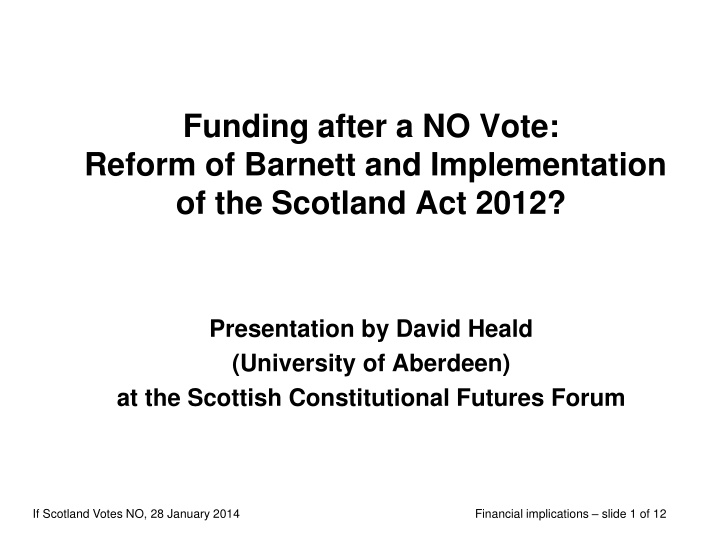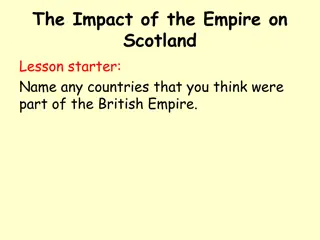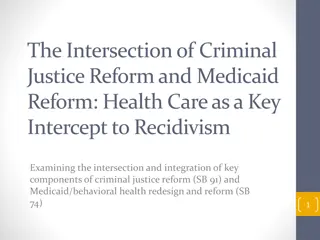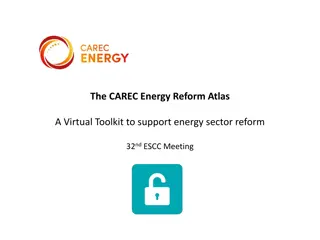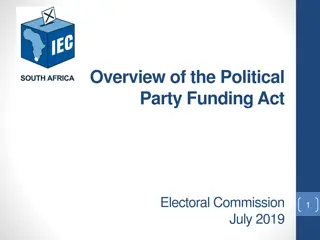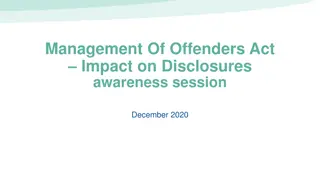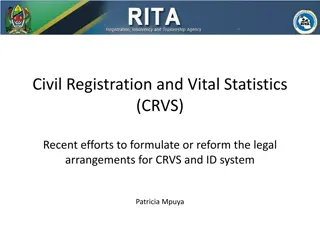Funding After a NO Vote: Reform of Barnett & Implementation of Scotland Act 2012
Presentation by David Heald at the Scottish Constitutional Futures Forum discussing the financial implications of the NO vote on funding, the challenges with the Barnett formula, and the impact on devolution financing in the UK. The presentation explores identifiable expenditure variances across regions and nations and UK expenditure on services in 2011-12.
Download Presentation

Please find below an Image/Link to download the presentation.
The content on the website is provided AS IS for your information and personal use only. It may not be sold, licensed, or shared on other websites without obtaining consent from the author.If you encounter any issues during the download, it is possible that the publisher has removed the file from their server.
You are allowed to download the files provided on this website for personal or commercial use, subject to the condition that they are used lawfully. All files are the property of their respective owners.
The content on the website is provided AS IS for your information and personal use only. It may not be sold, licensed, or shared on other websites without obtaining consent from the author.
E N D
Presentation Transcript
Funding after a NO Vote: Reform of Barnett and Implementation of the Scotland Act 2012? Presentation by David Heald (University of Aberdeen) at the Scottish Constitutional Futures Forum If Scotland Votes NO, 28 January 2014 Financial implications slide 1 of 12
Context Devolution coincided with a period of remarkably rapid public spending growth, now in considerable reverse The Barnett formula is attacked from all sides as unfair . Every territorial unit believes that Barnett is bad for them. Understanding of how this system works remains low. The 1997-2010 Labour Government consistently closed down debate but never articulated a defence of the Barnett system England has 84% of UK population (cf Ontario accounts for 35% of the Canadian population, and no federation is more unbalanced). This has profound implications for UK devolution financing The Scottish Independence Referendum has attracted more attention to expenditure relatives and to Barnett. The NO result has probably weakened Scotland s political clout within the United Kingdom. Some will now argue that Scotland s bluff has been called. Promises in 1979 of a better devolution deal in the event of a No vote turned sour Those urging a No vote have been offering Scotland a better devolution deal. However, this jars with widespread perceptions elsewhere that Scotland gets too good a deal now. Two members of the Holtham Commission suggested a Needs Assessment could result in a 4 billion cut in the Scottish block grant. Reform of Barnett is usually code for a worse deal for Scotland If Scotland Votes NO, 28 January 2014 Financial implications slide 2 of 12
How identifiable expenditure relatives vary over nations and regions Index (UK identifiable expenditure = 100) National Statistics 2007-08 outturn 2008-09 outturn 2009-10 outturn 2010-11 outturn 2011-12 outturn North East 108 109 108 108 107 North West 105 104 105 105 105 Yorkshire and the Humber 96 98 98 98 98 East Midlands 90 90 90 91 91 West Midlands 97 97 97 97 96 East 86 87 88 89 89 London 115 113 114 112 110 South East 85 87 86 86 87 South West 90 92 92 92 93 England 97 97 97 97 97 Scotland 118 115 114 114 115 Wales 111 110 109 111 111 Northern Ireland 125 123 120 120 121 Notes: (1) Distribution among English regions has nothing to do with the Barnett formula but flows from distribution formulae used within England. (2) There are no official estimates of indexes of comparable expenditure covered by the Barnett formula. (3) On the then definitions, 1987-88 indexes of identifiable expenditure have been reported as: England (95.6), Scotland (121.5), Wales (109.3) and Northern Ireland (145.8). These numbers were sensitive to data source. See Heald (Public Administration, 1994, p. 158). (4) There is noise in identifiable expenditure data from regionally-differentiated economic cycles. Source: Public Expenditure Statistical Analyses 2013, Table 9.2. If Scotland Votes NO, 28 January 2014 Financial implications slide 3 of 12
UK identifiable expenditure on services by function, country and region, per head indexed, 2011-12 1. General public 5. Environment 6. Housing and 3. Public order 8. Recreation, 4. Economic Total 9. Education culture and community 2. Defence and safety protection protection 10. Social Expenditure on Services amenities 7. Health services religion affairs North East North West Yorkshire and the Humber East Midlands West Midlands East London South East South West England Scotland Wales Northern Ireland 88 90 76 117 92 77 80 87 82 87 164 185 163 99 82 81 98 87 118 117 68 89 92 159 174 27 108 106 96 81 93 73 155 76 79 98 98 99 165 84 84 82 72 68 89 145 68 77 88 177 141 165 84 168 78 74 68 76 87 90 109 95 147 113 82 126 86 80 65 68 43 154 53 53 81 199 134 324 110 107 100 91 98 90 110 89 93 98 110 103 111 104 80 86 69 80 67 139 70 78 87 183 147 170 103 102 102 97 100 94 114 92 93 100 101 100 103 112 107 100 95 101 92 96 89 100 98 108 112 112 107 105 98 91 96 89 110 87 93 97 115 111 121 UK identifiable expenditure 100 100 100 100 100 100 100 100 100 100 100 % of Total Expenditure on Services 1% 0% 6% 6% 2% 2% 22% 1% 17% 43% 100% Notes: (1) Distribution among English regions has nothing to do with the Barnett formula but flows from distribution formulae used within England. (2) Indexes in this Table should be interpreted with care because (a) high indexes may result from only small proportions of expenditure being treated as Identifiable, and (b) functional spends differ massively in size. Source: Public Expenditure Statistical Analyses 2013, Tables 9.15 and 9.16. If Scotland Votes NO, 28 January 2014 Financial implications slide 4 of 12
Net Fiscal Balance: Scotland and the UK, 2007-08 to 2011-12 2007-08 2008-09 2009-10 2010-11 2011-12 Scotland ( million) Excluding North Sea revenue -11,110 -15,450 -20,385 -19,743 -18,159 Including North Sea revenue (per capita share) -10,480 -14,362 -19,839 -19,006 -17,217 Including North Sea revenue (geographical share) -3,998 -3,699 -14,475 -11,700 -7,586 UK -36,719 -97,539 -158,922 -140,967 -120,963 Scotland (% of GDP) Excluding North Sea revenue -9.7% -13.4% -18.1% -16.5% -14.6% Including North Sea revenue (per capita share) -9.0% -12.1% -17.2% -15.6% -13.5% Including North Sea revenue (geographical share) -2.9% -2.6% -10.7% -8.1% -5.0% UK -2.6% -6.9% -11.2% -9.5% -7.9% Source: Government Expenditure and Revenues in Scotland (2013), Table E4 If Scotland Votes NO, 28 January 2014 Financial implications slide 5 of 12
Origins and Survival of the Barnett Formula Long history of the use of formulae in UK territorial management Goschen formula used from 1888 until (at least) 1959. Although the Barnett formula is sometimes presented as a needs-based formula, this is inaccurate. It is an adjustment formula In 1978 the Barnett formula was probably seen as temporary and it is not clear how well its theoretical convergence properties were then understood. But an implicit assumption of over-funding , otherwise would not have distributed increments less generously than the inherited base. After 1979 the Conservative Government formalised the Scottish block and expenditure-switching powers Despite widespread attacks, the survival of the Barnett formula is not accidental: automatic adjustment (that limits conflict and saves time) suits the key actors expenditure-switching flexibility (that enhanced the budgetary power of originally the Secretary of State and later the Scottish Executive/Government) defence of the Barnett formula became a political objective of Scottish Office/Executive/Government ministers, whatever they said in public Scottish UK Cabinet ministers continuously at the Treasury from 1997-present expectation that a Needs Assessment would be technically difficult, costly and politically explosive strong flow of money post-devolution dampened discontents in Wales and Northern Ireland the system became Barnett-plus , with add-ons for Wales and Northern Ireland UK protection of health and education since 2010 has protected the devolved blocks and allowed the Devolved Administrations to soften cuts elsewhere in their programmes alternatives are more complicated, more difficult to manage or constrained by EU law If Scotland Votes NO, 28 January 2014 Financial implications slide 6 of 12
Fundamental Issues UK devolution finance is an expenditure-based system, deeply embedded within UK public expenditure planning: oLack of Transparency: derivation of formula consequentials is not made public and there is lots of noise (eg accounting changes, control system changes, transfers of function, reclassifications between Department Expenditure Limits (DEL) and Annually Managed Expenditure (AME)) (See Heald and McLeod, Regional Studies, 2005). No publication of comparable expenditure in England. The Treasury can game the baselines and comparability factors, and it sometimes does so. However, the Barnett system has provided an anchor since devolution, though misleading representations proliferate in part due to the lack of sufficient published data oDisputed concepts of territorial equity: London and the devolved countries have the highest index of Total Expenditure on Services per head (Slide 4). However, London argues that it generates much UK tax revenue (12.5% of taxpayers generating 22.2% of tax revenues) and Scotland argues that its geographical share of North Sea oil revenues is 90-95%. Growing political pressures to keep what you kill : note also the weakening of equalisation within English local government o Revenue is largely irrelevant in an expenditure-based system: assignment of tax revenues does not confer devolved discretion; assignment of tax bases only confers discretion if the tax rates can credibly be varied upwards and downwards. The tartan tax power atrophied and the Calman income tax might suffer the same fate. Other taxes under discussion (Airport Passenger Duty and Corporation Tax) are desired only to reduce them There is no meaningful fiscal autonomy for the Scottish Parliament if the system were to entail Scotland receiving the Scottish proceeds of UK tax rates on UK-determined Scottish tax bases. Accountability gains derive from being able to take credible decisions at the margin through changes in tax rates (and possibly tax bases). Otherwise, notionally devolved taxes approximate to assigned revenues, introducing uncontrollable volatility unless there are complicated smoothing mechanisms If Scotland Votes NO, 28 January 2014 Financial implications slide 7 of 12
(1) The Calman Future Whether to have a Needs Assessment, which could be (a) broad brush (few indicators as proposed by the Holtham Commission in 2010) or (b) highly detailed (on Australian model). Divergent policies (eg university tuition fees, prescription charges, free personal care, bridge tolls) are complicating factors. Issues of (a) whose policies are regarded as the baseline, and (b) implications of relative population growth and changes in demographic structure. It would be hard to maintain the integrity of the Needs Assessment (against leaks and campaigns) and the losers (widely assumed to be Scotland and Northern Ireland) would complain bitterly Territorial Exchequer Board, independent of the Treasury, to co-ordinate the Needs Assessment, to provide a data platform, and to verify data (NB the problem of counting the UK population, let alone measuring needs-weighted population) Transitional formula almost certainly needed after a Needs Assessment, and some form of prior agreement might be a prerequisite of commitment. See Heald and McLeod (IPPR, 2002) for how this might be done, but that was in the context of strong expenditure growth The tartan tax power, validated by the second question in the 1997 Referendum, was never used and has now been repealed. Following the Calman Report (2009), a Canadian-style 10 percentage-points tax transfer from UK to Scotland from 2016-17. Unlike the tartan tax (restricted to the basic rate, hence limiting maximum loss or gain), this applies to all taxpayers. Without a ceiling on loss/gain, verifying Scottish residence becomes critical. Issue of how much priority HMRC will attach to enforcement. In 2010- 11, 40% of UK income tax revenues from Scotland came from 7% of taxpayers (192,000 taxpayers) and 19.6% from 1.29% (35,000). Without a ceiling on loss/gain, behavioural effects moving residence or affecting to do so will be larger If Scotland Votes NO, 28 January 2014 Financial implications slide 8 of 12
(1) The Calman Future (continued) Tartan tax was estimated in 2011-12 to yield 1,200 million if the full upwards power were to be used (a Treasury estimate taking no account of behavioural effects). The Scottish Rate of Income Tax (Calman income tax, now SRIT) is estimated to yield circa 5 billion in 2016-17 if levied at 10p (ie matching the rate elsewhere in the UK). However, other than administrative costs to be met by the Scottish Government, at 10p there is no change in ability-to-spend Crucial change is that the Scottish Parliament, on a motion from Scottish ministers, must make a tax decision, otherwise lose the circa 5 billion that will have been deducted from the block grant. The tartan tax required no action, unless levied The Scottish Rate of Income Tax is unusable unless there is a securely-anchored, verifiable and transparent devolution funding system When the Scottish Parliament/Government complains about reductions in the block grant, the retort from the UK Government will be Well, use your tax powers! Unlike tartan tax, 10p reduction applies to all income tax bands from 2016-17, so UK rate applicable in Scotland would become 10%, 30% and 35%, with the Scottish Rate of Income Tax on top SRIT applies to employment, self-employment and pensions income but not to savings and investment income which represented 5% of the total income of Scottish taxpayers in 2010-11. There are practical reasons for exclusion but this will generate arguments about fairness Setting SRIT at 10p would replace the circa 5 billion reduction of block grant (to be indexed), less HMRC administration costs. Estimated set-up costs 40-45 million; annual running costs 4.2 million. Revenue would be based on Office for Budget Responsibility (OBR) forecast but then converted to actual yield (revision mechanism supported by temporary borrowing if there were shortfalls on forecasts and a secure cash reserve if revenues higher). Memorandum of Understanding between Scottish Government and HMRC, under which former will reimburse HMRC at full economic cost and meet additional charges of HMRC s IT contractors If Scotland Votes NO, 28 January 2014 Financial implications slide 9 of 12
(1) The Calman Future (continued) From 2013-14, the UK has adopted a statutory residence test as opposed to relying heavily on accumulated case law. Scottish taxpayers are defined as a subset of UK taxpayers, to be given an S prefix to their tax code. Non-UK residents cannot be Scottish taxpayers. Complicated rules in Scotland Act 2012 but straightforward for most taxpayers (main residence). Cases where there is doubt (and scope for avoidance) are likely to relate to UK- resident, high-income taxpayers In relation to self-employment (including unincorporated businesses), issue of relationship between effective tax rate relative to that for incorporated status. With Corporation Tax rates in decline across OECD countries, incorporated status may give tax savings in relation to: National Insurance Contributions; the timing of when income is received; and Capital Gains Tax treatment. However, there are costs to incorporation and to exiting from it Interactions of UK social security system and a partially-devolved income tax may cause difficulties, both administratively and in terms of marginal effective tax rates Two out of the four Calman minor taxes have been devolved from 1 April 2015. Stamp Duty Land Tax (to be replaced in Scotland by Land and Buildings Transaction Tax) and Landfill Tax (to be replaced by Scottish Landfill Tax). Revenue Scotland established to administer these taxes (an embryo SHMRC?). For 2015-16, OBR forecasts SDLT ( 491 million) and Landfill Tax ( 104 million). Such taxes are highly sensitive to the state of the economy. Future revenue risk, upwards and downwards, for the these devolved taxes is transferred, and (indexed) deductions will be made from the Scottish block Not devolved are Aggregates Levy and Airport Passenger Duty (there is limited devolution of APD to Northern Ireland). Such taxes are vulnerable to a race to the bottom and to European Commission challenges as state aid. Provision to devolve other taxes by mutual agreement From 2015-16, Scottish Government can borrow up to 10% of Capital DEL each year, with statutory maximum of 2.2 billion. Narrower interim borrowing power from 2011-12 If Scotland Votes NO, 28 January 2014 Financial implications slide 10 of 12
(2) Beyond Calman: Devo Plus or Devo Max The Devolved Administrations receiving their national proceeds of taxes controlled by the UK Government is not fiscal autonomy . It is an illusion that raising at least half the money they spend brings autonomy or accountability if tax base and rate are outside devolved control. Psychological and presentational benefits may be claimed, but this is assignment of revenues without the protections afforded by the constitutionally-based German equalisation system. Are Devo Plus and Devo Max intended to lead to more spending (protecting services) or less (hard budget constraint)? Evolution since 1999 has been to bring Wales and Northern Ireland closer to the Scottish model, thus reducing asymmetry across the devolved countries. Scottish developments involving devolved taxes re- introduce asymmetry. Wales has 48% of its population living within 25 crow-fly miles of the English border, extensive cross-border commuting, and average income levels are low, meaning that tax-base equalisation would be necessary. If adopted in Wales, intention of setting rates lower than in England to attract rich taxpayers across the border? Crucial questions as to which tier of government controls the tax base and which controls allowances and tax rates some design constraints emanate from membership of the European Union and the judgments of the Court of First Instance/European Court of Justice (Azores, Basque and Gibraltar cases). Also practical constraints (avoidance possibilities and fraud) on devolving Corporation Tax or VAT: credible candidates are income tax (eg transfer of tax points in the Canadian sense) and property taxes (already devolved and, like England, council tax bands still based on 1991 valuations and tax rates subjected to centrally-imposed freeze) Full devolution of income tax is one possibility, but the issues of (a) usability and (b) interaction with the UK social security system are obstacles to this. Also, vulnerable to UK switch to less income tax but more VAT (political risk) and macro-fiscal risks (when have no policy control) If have considerable taxation powers, there must be substantive (not just short-term to deal with timing differences) borrowing powers, and UK Governments may be reluctant to grant these to (what might be) hostile and/or separatist governments If Scotland Votes NO, 28 January 2014 Financial implications slide 11 of 12
Conclusions The way that different countries handle internal territorial issues depends heavily on history and political culture. There is no single or simple solution as to how a devolution financing system should work. The United Kingdom has its particularities, one of which is inadequate legitimacy across the nations and regions. Controversy and political conflict are inherent in territorial public finance. But systems can be made to work if there is the political will to do so The fiscal structure of the United Kingdom points strongly towards the use of an expenditure-based rather than revenue-based system. The 1921-72 Stormont revenue- based system was quickly subverted. The risk of a supposedly revenue-based system is that discretion is unusable, for technical reasons (eg lack of administrative capacity or information-sharing) or for political reasons (Devolved Administrations dare not either increase or reduce tax rates) The Barnett formula may in time be ceremonially abolished, but my expectation is that it will have an offspring. Per capita convergence on Barnett-controlled expenditure (so-called Barnett squeeze ) has not gone as far as predicted 30 years ago. Expenditure reductions set this process into reverse. Transparency in the form of full documentation is vital now: NB the 1984 National Archives release about cutting secretly and the Treasury reporting tartan tax potential yield for 2011-12 under Section 76 (Scotland Act 1998) when no capacity-to-use A key issue now is whether the Calman income tax will atrophy (just match the UK rate), just as did the tartan tax in very different budgetary circumstances Although the inclination of all three Devolved Administrations is to spend more than in England, most proposals are to tax less (NB a decision on devolved Corporation Tax for Northern Ireland has been deferred until after the Scottish Independence Referendum) If Scotland Votes NO, 28 January 2014 Financial implications slide 12 of 12
